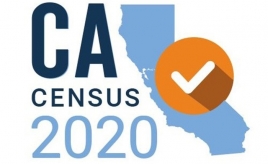Tracking California’s Census Response Rate – Who’s Ahead And Who’s Behind?
Tuesday, April 21, 2020
BY MARK HEDIN
Ethnic Media Services
A month after the first invitations to participate in the 2020 census were mailed out, 48.3% of California’s known households have completed the questionnaire, putting the Golden State just slightly ahead of the country’s 47.9% rate. This despite the fact that California has 11 million people considered “hard to count” — the most of any state.
California budgeted $187.3 million for census outreach efforts to get everyone counted. It’s ahead of New York, which also dedicated tens of millions to outreach efforts. Texas, by comparison, made no statewide expenditures.
With counting set to continue into August, California at 41.8% ranks 20th in how many households have filed by Internet. The national rate (2020census.gov/en/response-rates) for Internet responses — the Census Bureau’s preferred response methodology — currently is 39.9%.
But the San Francisco Bay Area leads the way in California’s overall response. Santa Clara, San Mateo, Alameda and Contra Costa counties all have responded above 50% so far. In 2010, those four counties all outdid the state’s 68.2% overall response rate.
San Francisco, both a county and a city, has a 41.9% response rate that’s slightly higher than the city of Fresno’s 41.5% and tops Los Angeles’ 34.4%, but trails Sacramento (45.7%), San Diego (48.8%) and San Jose (51.1%).
Nationwide, most major urban areas are responding below their states’ rates. New York City comes in at 33.9% in a state reporting at 38.3%. Houston’s 37.1% trails Texas’ 39%, Chicago’s 38.6% trails Illinois’ 48.5%, Atlanta’s 39.6% trails Georgia’s 41.5%, and St. Louis, at 36.8%, similarly trails Missouri’s 43.6%.
Major cities also typically are more challenging to enumerate. In California, that’s holding true for San Francisco and Los Angeles, but besides San Diego and San Jose, Oakland and Berkeley, too, both at 49.2% are also doing better than the state as a whole.
East Palo Alto is out-reporting Beverly Hills, 36.35% to 34.2%, but neither is as strong as San Bernardino, 40.3% or Riverside, 45.5%. All four cities hit above 60% in 2010.
As in 2010, California’s lowest response rates are coming from the counties along the Nevada border. In Sierra County, just west of Reno, only 4.9% have responded so far. In 2010, when only 44.1% of that county’s households responded, it ranked as the state’s second-most underpopulated county. Alpine County had the state’s lowest record 10 years ago, with just a 20.2% response rate. So far this year, it’s at 9.8%.
Trinity, another trouble spot, shows 5% responding, nearly all using the Internet. In Lake County, it’s the reverse — a 27.2% response rate with only 18.5% using the Internet. Within Mendocino’s 31.7% response rate, 25.7% is by Internet.
The Central Valley is another story. In 2010, every county from Sacramento to Riverside reported at rates of at least 63%. So far in 2020, Madera County’s 36.8% is bringing up the rear. Kern County is at 39.3%, King’s at 39.4%, Tulare’s at 39.5%, Merced’s at 39.8%, and San Bernardino, Fresno and Riverside are at 40.4%, 41.6% and 42.2% respectively. Sacramento County is at 48.7%.
But some counties are much more populous than others. Even if Riverside County, the fourth-most populous in the state, ultimately reports at 80%, the number of people still not counted will exceed the entire population of Alpine County to the north.
When it comes to the census’ first-ever use of the Internet as a way to be counted, the Central Valley has so far trended more toward using mail and telephone methods than have other regions of the state. The Internet is still the primary way people respond, but in Sacramento County, 2.1% of households have used other ways. In Riverside and San Bernardino counties, it’s 4.1% and 4.7%, respectively, and 8% or more in Fresno, Kern and Merced counties and 10.7% in Tulare.
The census is not yet reporting on response rates based on ethnicity, but Indian Country, with 100 state-recognized reservations or rancherias in California alone, shows there is much to be done — rates are neither strong nor consistent.
The Table Bluff Rancheria boasts a 31.5% response rate, after totaling 38.2% in 2010, and Trinidad Rancheria, at 17.4%, has almost matched its 2010 tally of 19%. But the Tule River Reservation’s 9.4% response, all Internet, is far below its 48.6% in 2010.
Hoopa Valley is at 3.1%, also all Internet, but the Census Bureau doesn’t report numbers for 2010. Hopland Reservation, at 25.3%, 8.9% via the Internet, hit 37.5% in 2010. Pala’s 3.6% is all Internet, with no data available for 2010.
If yours is a household not yet counted, you can change that by going to: my2020Census.gov or calling (844) 330-2020. Starting in May and continuing through Aug. 14, the Census Bureau will send out enumerators to knock on the doors of households that haven’t responded. The enumerators will visit to get the data that determines, among other things, political representation and up to $1.5 trillion in annual federal spending for more than 300 programs.
https://massispost.com/2020/04/tracking-californias-census-response-rate-whos-ahead-and-whos-behind/





